Case Study: Analyzing Jake's Diabetes and Health Status
VerifiedAdded on 2021/09/24
|6
|1777
|278
Homework Assignment
AI Summary
This assignment analyzes Jake's laboratory results, which indicate a diagnosis of Type 1 diabetes mellitus. The analysis includes commenting on concerning blood and urine results, such as elevated random blood sugar and glucose in urine, and explaining symptoms like polyuria and polydipsia. The pathophysiology of the disease is discussed, focusing on the autoimmune destruction of pancreatic beta cells and the resulting cellular changes. The assignment also examines Jake's oral glucose tolerance test and HbA1c levels, offering suggestions for optimizing his health status. These suggestions include insulin injections, increased fluid intake, dietary changes, and exercise to manage blood sugar and electrolyte imbalances. References are provided to support the analysis.
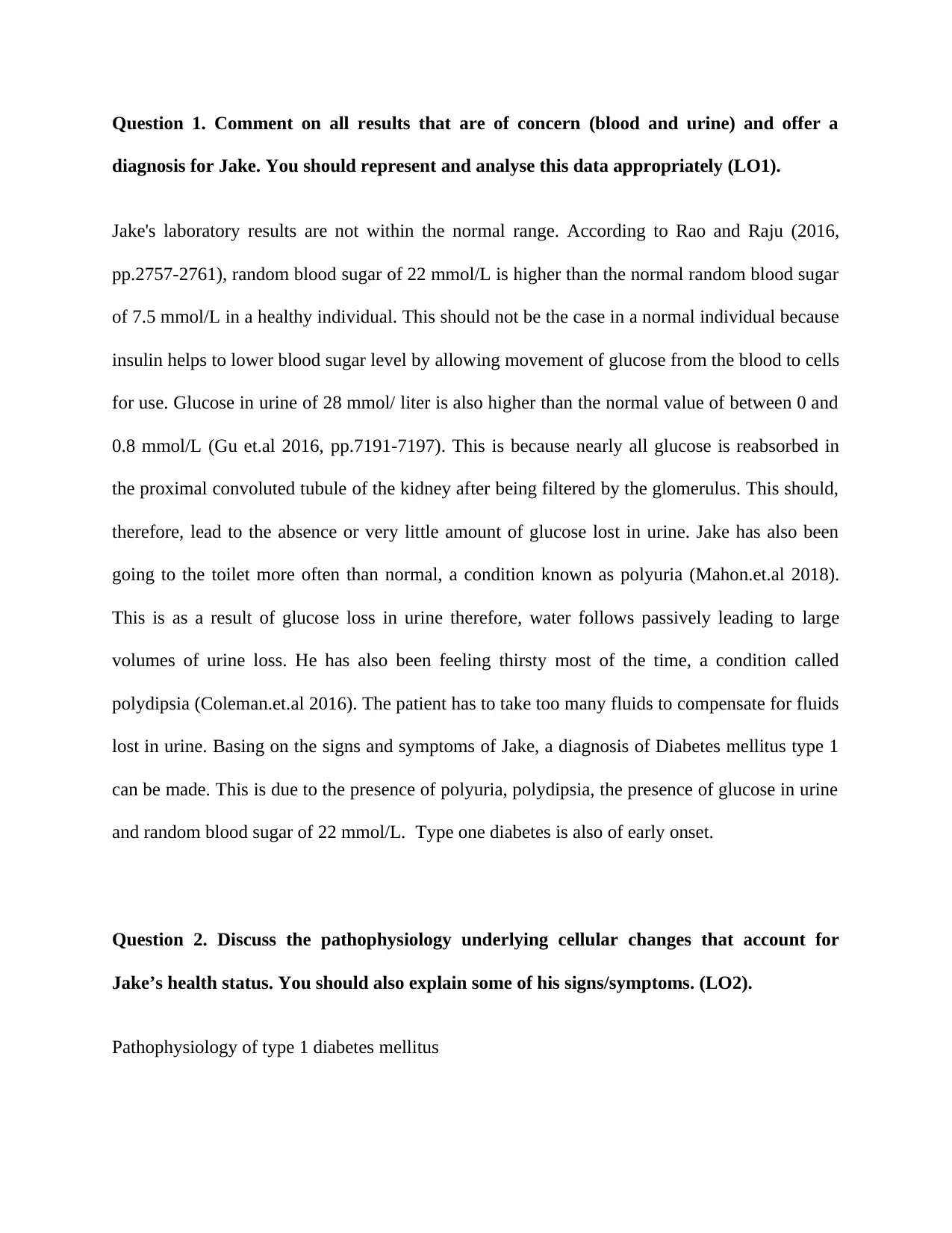
Question 1. Comment on all results that are of concern (blood and urine) and offer a
diagnosis for Jake. You should represent and analyse this data appropriately (LO1).
Jake's laboratory results are not within the normal range. According to Rao and Raju (2016,
pp.2757-2761), random blood sugar of 22 mmol/L is higher than the normal random blood sugar
of 7.5 mmol/L in a healthy individual. This should not be the case in a normal individual because
insulin helps to lower blood sugar level by allowing movement of glucose from the blood to cells
for use. Glucose in urine of 28 mmol/ liter is also higher than the normal value of between 0 and
0.8 mmol/L (Gu et.al 2016, pp.7191-7197). This is because nearly all glucose is reabsorbed in
the proximal convoluted tubule of the kidney after being filtered by the glomerulus. This should,
therefore, lead to the absence or very little amount of glucose lost in urine. Jake has also been
going to the toilet more often than normal, a condition known as polyuria (Mahon.et.al 2018).
This is as a result of glucose loss in urine therefore, water follows passively leading to large
volumes of urine loss. He has also been feeling thirsty most of the time, a condition called
polydipsia (Coleman.et.al 2016). The patient has to take too many fluids to compensate for fluids
lost in urine. Basing on the signs and symptoms of Jake, a diagnosis of Diabetes mellitus type 1
can be made. This is due to the presence of polyuria, polydipsia, the presence of glucose in urine
and random blood sugar of 22 mmol/L. Type one diabetes is also of early onset.
Question 2. Discuss the pathophysiology underlying cellular changes that account for
Jake’s health status. You should also explain some of his signs/symptoms. (LO2).
Pathophysiology of type 1 diabetes mellitus
diagnosis for Jake. You should represent and analyse this data appropriately (LO1).
Jake's laboratory results are not within the normal range. According to Rao and Raju (2016,
pp.2757-2761), random blood sugar of 22 mmol/L is higher than the normal random blood sugar
of 7.5 mmol/L in a healthy individual. This should not be the case in a normal individual because
insulin helps to lower blood sugar level by allowing movement of glucose from the blood to cells
for use. Glucose in urine of 28 mmol/ liter is also higher than the normal value of between 0 and
0.8 mmol/L (Gu et.al 2016, pp.7191-7197). This is because nearly all glucose is reabsorbed in
the proximal convoluted tubule of the kidney after being filtered by the glomerulus. This should,
therefore, lead to the absence or very little amount of glucose lost in urine. Jake has also been
going to the toilet more often than normal, a condition known as polyuria (Mahon.et.al 2018).
This is as a result of glucose loss in urine therefore, water follows passively leading to large
volumes of urine loss. He has also been feeling thirsty most of the time, a condition called
polydipsia (Coleman.et.al 2016). The patient has to take too many fluids to compensate for fluids
lost in urine. Basing on the signs and symptoms of Jake, a diagnosis of Diabetes mellitus type 1
can be made. This is due to the presence of polyuria, polydipsia, the presence of glucose in urine
and random blood sugar of 22 mmol/L. Type one diabetes is also of early onset.
Question 2. Discuss the pathophysiology underlying cellular changes that account for
Jake’s health status. You should also explain some of his signs/symptoms. (LO2).
Pathophysiology of type 1 diabetes mellitus
Paraphrase This Document
Need a fresh take? Get an instant paraphrase of this document with our AI Paraphraser
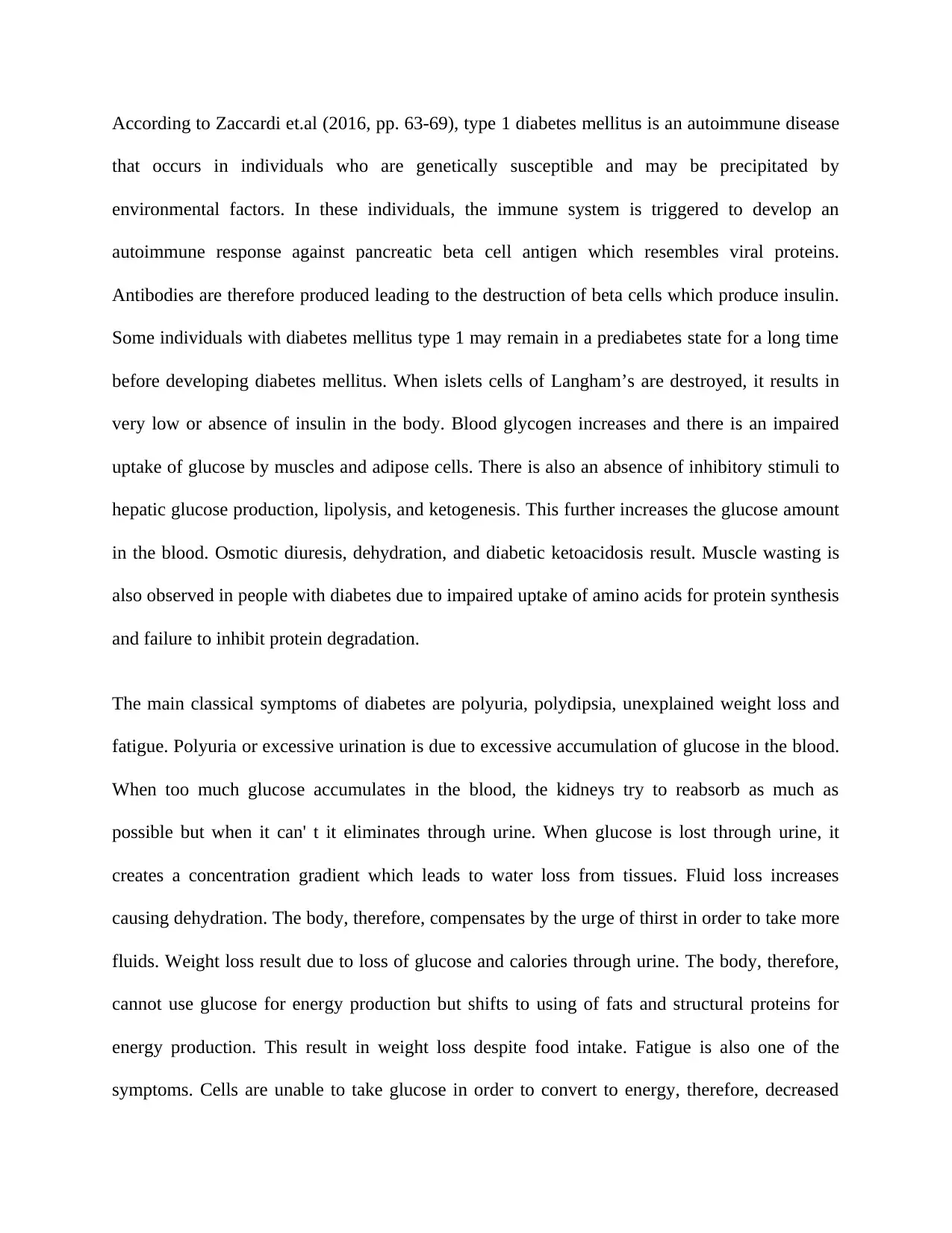
According to Zaccardi et.al (2016, pp. 63-69), type 1 diabetes mellitus is an autoimmune disease
that occurs in individuals who are genetically susceptible and may be precipitated by
environmental factors. In these individuals, the immune system is triggered to develop an
autoimmune response against pancreatic beta cell antigen which resembles viral proteins.
Antibodies are therefore produced leading to the destruction of beta cells which produce insulin.
Some individuals with diabetes mellitus type 1 may remain in a prediabetes state for a long time
before developing diabetes mellitus. When islets cells of Langham’s are destroyed, it results in
very low or absence of insulin in the body. Blood glycogen increases and there is an impaired
uptake of glucose by muscles and adipose cells. There is also an absence of inhibitory stimuli to
hepatic glucose production, lipolysis, and ketogenesis. This further increases the glucose amount
in the blood. Osmotic diuresis, dehydration, and diabetic ketoacidosis result. Muscle wasting is
also observed in people with diabetes due to impaired uptake of amino acids for protein synthesis
and failure to inhibit protein degradation.
The main classical symptoms of diabetes are polyuria, polydipsia, unexplained weight loss and
fatigue. Polyuria or excessive urination is due to excessive accumulation of glucose in the blood.
When too much glucose accumulates in the blood, the kidneys try to reabsorb as much as
possible but when it can' t it eliminates through urine. When glucose is lost through urine, it
creates a concentration gradient which leads to water loss from tissues. Fluid loss increases
causing dehydration. The body, therefore, compensates by the urge of thirst in order to take more
fluids. Weight loss result due to loss of glucose and calories through urine. The body, therefore,
cannot use glucose for energy production but shifts to using of fats and structural proteins for
energy production. This result in weight loss despite food intake. Fatigue is also one of the
symptoms. Cells are unable to take glucose in order to convert to energy, therefore, decreased
that occurs in individuals who are genetically susceptible and may be precipitated by
environmental factors. In these individuals, the immune system is triggered to develop an
autoimmune response against pancreatic beta cell antigen which resembles viral proteins.
Antibodies are therefore produced leading to the destruction of beta cells which produce insulin.
Some individuals with diabetes mellitus type 1 may remain in a prediabetes state for a long time
before developing diabetes mellitus. When islets cells of Langham’s are destroyed, it results in
very low or absence of insulin in the body. Blood glycogen increases and there is an impaired
uptake of glucose by muscles and adipose cells. There is also an absence of inhibitory stimuli to
hepatic glucose production, lipolysis, and ketogenesis. This further increases the glucose amount
in the blood. Osmotic diuresis, dehydration, and diabetic ketoacidosis result. Muscle wasting is
also observed in people with diabetes due to impaired uptake of amino acids for protein synthesis
and failure to inhibit protein degradation.
The main classical symptoms of diabetes are polyuria, polydipsia, unexplained weight loss and
fatigue. Polyuria or excessive urination is due to excessive accumulation of glucose in the blood.
When too much glucose accumulates in the blood, the kidneys try to reabsorb as much as
possible but when it can' t it eliminates through urine. When glucose is lost through urine, it
creates a concentration gradient which leads to water loss from tissues. Fluid loss increases
causing dehydration. The body, therefore, compensates by the urge of thirst in order to take more
fluids. Weight loss result due to loss of glucose and calories through urine. The body, therefore,
cannot use glucose for energy production but shifts to using of fats and structural proteins for
energy production. This result in weight loss despite food intake. Fatigue is also one of the
symptoms. Cells are unable to take glucose in order to convert to energy, therefore, decreased
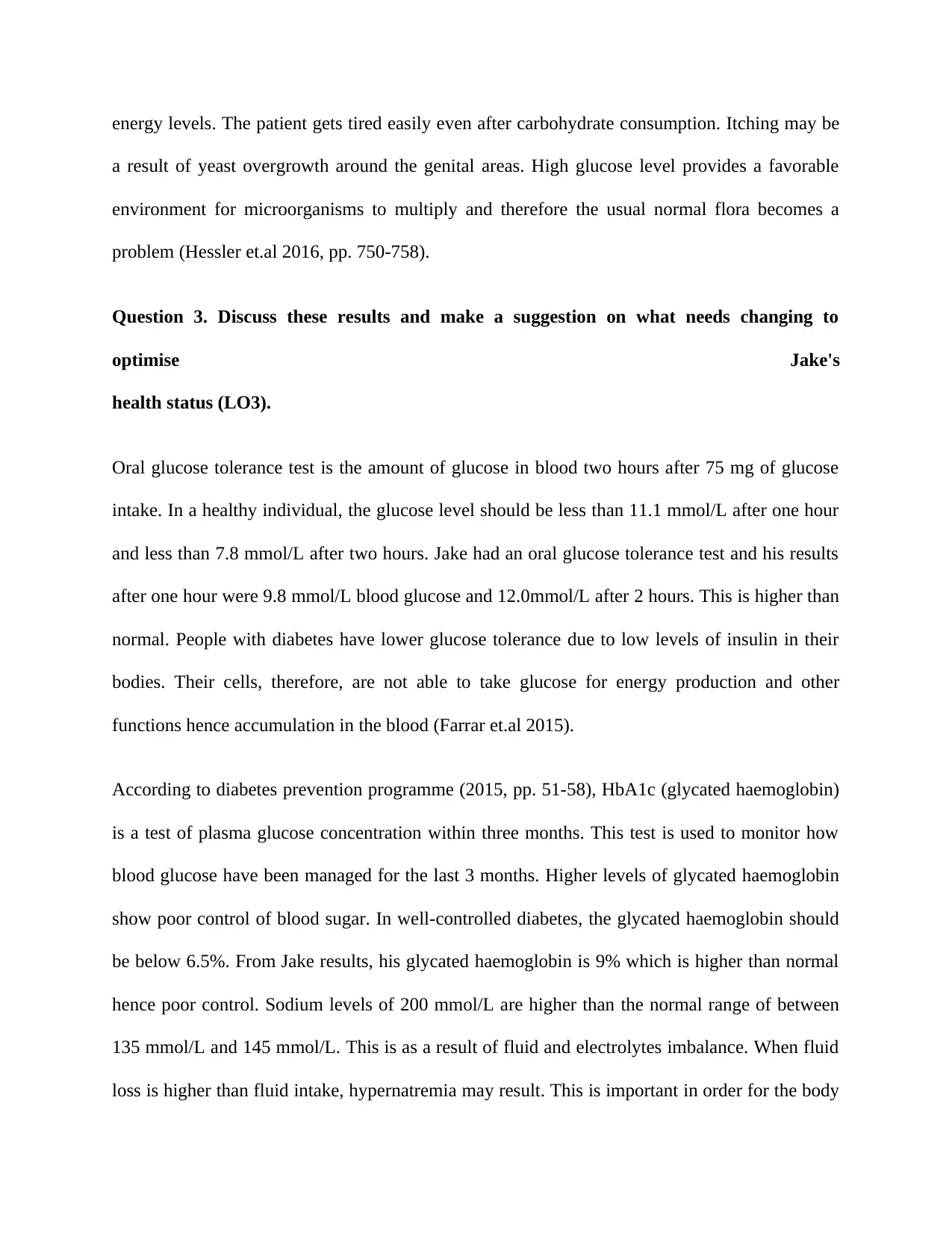
energy levels. The patient gets tired easily even after carbohydrate consumption. Itching may be
a result of yeast overgrowth around the genital areas. High glucose level provides a favorable
environment for microorganisms to multiply and therefore the usual normal flora becomes a
problem (Hessler et.al 2016, pp. 750-758).
Question 3. Discuss these results and make a suggestion on what needs changing to
optimise Jake's
health status (LO3).
Oral glucose tolerance test is the amount of glucose in blood two hours after 75 mg of glucose
intake. In a healthy individual, the glucose level should be less than 11.1 mmol/L after one hour
and less than 7.8 mmol/L after two hours. Jake had an oral glucose tolerance test and his results
after one hour were 9.8 mmol/L blood glucose and 12.0mmol/L after 2 hours. This is higher than
normal. People with diabetes have lower glucose tolerance due to low levels of insulin in their
bodies. Their cells, therefore, are not able to take glucose for energy production and other
functions hence accumulation in the blood (Farrar et.al 2015).
According to diabetes prevention programme (2015, pp. 51-58), HbA1c (glycated haemoglobin)
is a test of plasma glucose concentration within three months. This test is used to monitor how
blood glucose have been managed for the last 3 months. Higher levels of glycated haemoglobin
show poor control of blood sugar. In well-controlled diabetes, the glycated haemoglobin should
be below 6.5%. From Jake results, his glycated haemoglobin is 9% which is higher than normal
hence poor control. Sodium levels of 200 mmol/L are higher than the normal range of between
135 mmol/L and 145 mmol/L. This is as a result of fluid and electrolytes imbalance. When fluid
loss is higher than fluid intake, hypernatremia may result. This is important in order for the body
a result of yeast overgrowth around the genital areas. High glucose level provides a favorable
environment for microorganisms to multiply and therefore the usual normal flora becomes a
problem (Hessler et.al 2016, pp. 750-758).
Question 3. Discuss these results and make a suggestion on what needs changing to
optimise Jake's
health status (LO3).
Oral glucose tolerance test is the amount of glucose in blood two hours after 75 mg of glucose
intake. In a healthy individual, the glucose level should be less than 11.1 mmol/L after one hour
and less than 7.8 mmol/L after two hours. Jake had an oral glucose tolerance test and his results
after one hour were 9.8 mmol/L blood glucose and 12.0mmol/L after 2 hours. This is higher than
normal. People with diabetes have lower glucose tolerance due to low levels of insulin in their
bodies. Their cells, therefore, are not able to take glucose for energy production and other
functions hence accumulation in the blood (Farrar et.al 2015).
According to diabetes prevention programme (2015, pp. 51-58), HbA1c (glycated haemoglobin)
is a test of plasma glucose concentration within three months. This test is used to monitor how
blood glucose have been managed for the last 3 months. Higher levels of glycated haemoglobin
show poor control of blood sugar. In well-controlled diabetes, the glycated haemoglobin should
be below 6.5%. From Jake results, his glycated haemoglobin is 9% which is higher than normal
hence poor control. Sodium levels of 200 mmol/L are higher than the normal range of between
135 mmol/L and 145 mmol/L. This is as a result of fluid and electrolytes imbalance. When fluid
loss is higher than fluid intake, hypernatremia may result. This is important in order for the body
⊘ This is a preview!⊘
Do you want full access?
Subscribe today to unlock all pages.

Trusted by 1+ million students worldwide
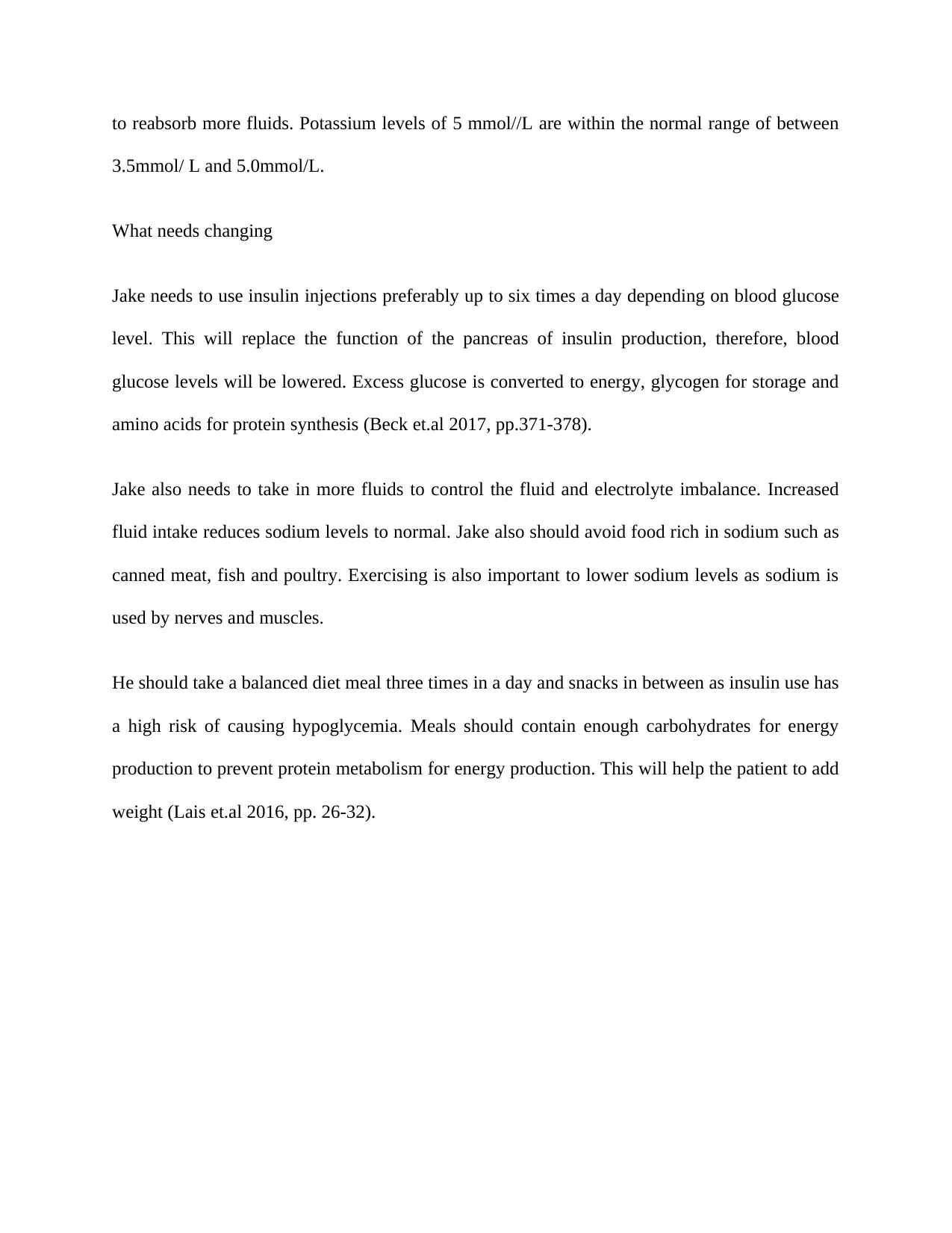
to reabsorb more fluids. Potassium levels of 5 mmol//L are within the normal range of between
3.5mmol/ L and 5.0mmol/L.
What needs changing
Jake needs to use insulin injections preferably up to six times a day depending on blood glucose
level. This will replace the function of the pancreas of insulin production, therefore, blood
glucose levels will be lowered. Excess glucose is converted to energy, glycogen for storage and
amino acids for protein synthesis (Beck et.al 2017, pp.371-378).
Jake also needs to take in more fluids to control the fluid and electrolyte imbalance. Increased
fluid intake reduces sodium levels to normal. Jake also should avoid food rich in sodium such as
canned meat, fish and poultry. Exercising is also important to lower sodium levels as sodium is
used by nerves and muscles.
He should take a balanced diet meal three times in a day and snacks in between as insulin use has
a high risk of causing hypoglycemia. Meals should contain enough carbohydrates for energy
production to prevent protein metabolism for energy production. This will help the patient to add
weight (Lais et.al 2016, pp. 26-32).
3.5mmol/ L and 5.0mmol/L.
What needs changing
Jake needs to use insulin injections preferably up to six times a day depending on blood glucose
level. This will replace the function of the pancreas of insulin production, therefore, blood
glucose levels will be lowered. Excess glucose is converted to energy, glycogen for storage and
amino acids for protein synthesis (Beck et.al 2017, pp.371-378).
Jake also needs to take in more fluids to control the fluid and electrolyte imbalance. Increased
fluid intake reduces sodium levels to normal. Jake also should avoid food rich in sodium such as
canned meat, fish and poultry. Exercising is also important to lower sodium levels as sodium is
used by nerves and muscles.
He should take a balanced diet meal three times in a day and snacks in between as insulin use has
a high risk of causing hypoglycemia. Meals should contain enough carbohydrates for energy
production to prevent protein metabolism for energy production. This will help the patient to add
weight (Lais et.al 2016, pp. 26-32).
Paraphrase This Document
Need a fresh take? Get an instant paraphrase of this document with our AI Paraphraser
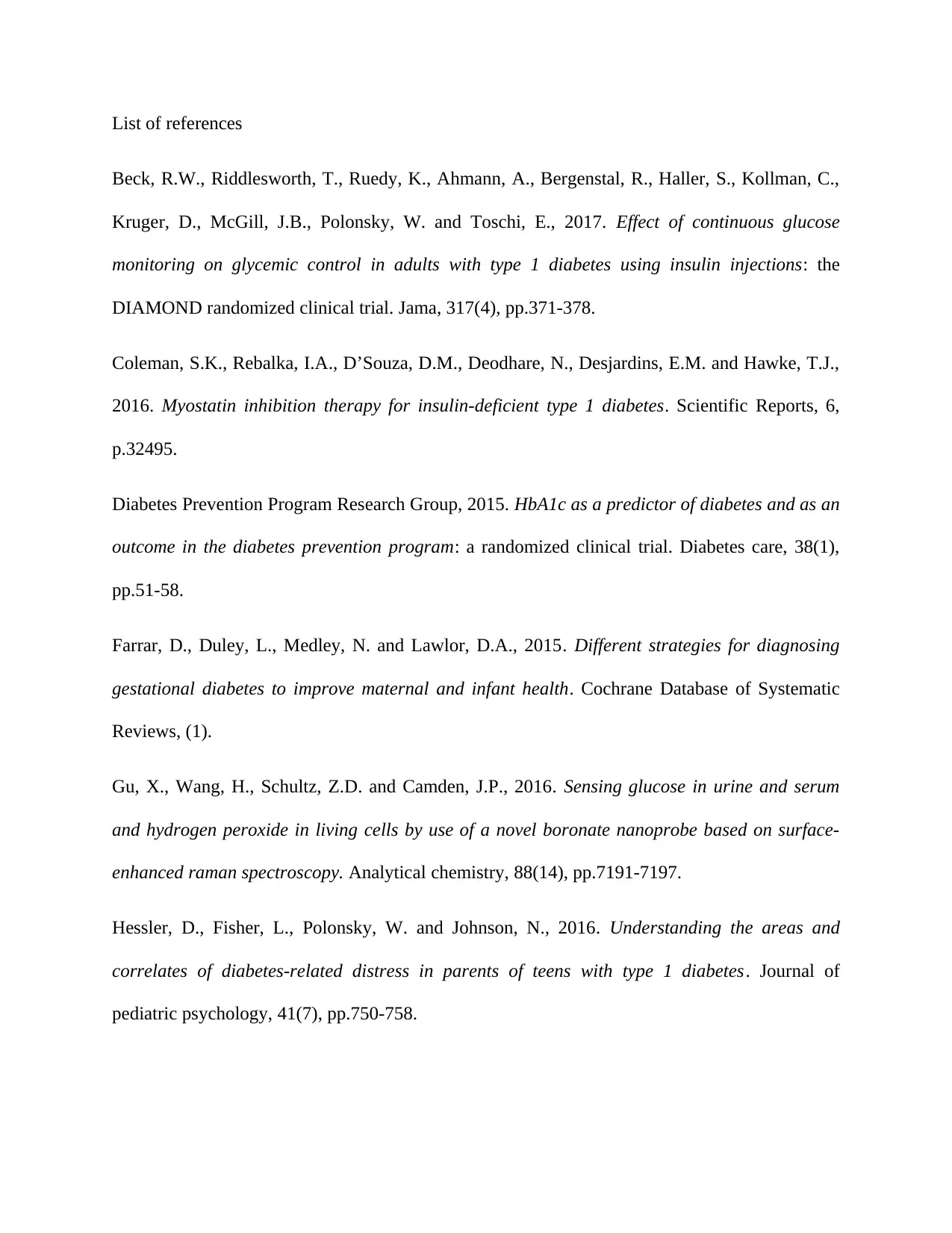
List of references
Beck, R.W., Riddlesworth, T., Ruedy, K., Ahmann, A., Bergenstal, R., Haller, S., Kollman, C.,
Kruger, D., McGill, J.B., Polonsky, W. and Toschi, E., 2017. Effect of continuous glucose
monitoring on glycemic control in adults with type 1 diabetes using insulin injections: the
DIAMOND randomized clinical trial. Jama, 317(4), pp.371-378.
Coleman, S.K., Rebalka, I.A., D’Souza, D.M., Deodhare, N., Desjardins, E.M. and Hawke, T.J.,
2016. Myostatin inhibition therapy for insulin-deficient type 1 diabetes. Scientific Reports, 6,
p.32495.
Diabetes Prevention Program Research Group, 2015. HbA1c as a predictor of diabetes and as an
outcome in the diabetes prevention program: a randomized clinical trial. Diabetes care, 38(1),
pp.51-58.
Farrar, D., Duley, L., Medley, N. and Lawlor, D.A., 2015. Different strategies for diagnosing
gestational diabetes to improve maternal and infant health. Cochrane Database of Systematic
Reviews, (1).
Gu, X., Wang, H., Schultz, Z.D. and Camden, J.P., 2016. Sensing glucose in urine and serum
and hydrogen peroxide in living cells by use of a novel boronate nanoprobe based on surface-
enhanced raman spectroscopy. Analytical chemistry, 88(14), pp.7191-7197.
Hessler, D., Fisher, L., Polonsky, W. and Johnson, N., 2016. Understanding the areas and
correlates of diabetes-related distress in parents of teens with type 1 diabetes. Journal of
pediatric psychology, 41(7), pp.750-758.
Beck, R.W., Riddlesworth, T., Ruedy, K., Ahmann, A., Bergenstal, R., Haller, S., Kollman, C.,
Kruger, D., McGill, J.B., Polonsky, W. and Toschi, E., 2017. Effect of continuous glucose
monitoring on glycemic control in adults with type 1 diabetes using insulin injections: the
DIAMOND randomized clinical trial. Jama, 317(4), pp.371-378.
Coleman, S.K., Rebalka, I.A., D’Souza, D.M., Deodhare, N., Desjardins, E.M. and Hawke, T.J.,
2016. Myostatin inhibition therapy for insulin-deficient type 1 diabetes. Scientific Reports, 6,
p.32495.
Diabetes Prevention Program Research Group, 2015. HbA1c as a predictor of diabetes and as an
outcome in the diabetes prevention program: a randomized clinical trial. Diabetes care, 38(1),
pp.51-58.
Farrar, D., Duley, L., Medley, N. and Lawlor, D.A., 2015. Different strategies for diagnosing
gestational diabetes to improve maternal and infant health. Cochrane Database of Systematic
Reviews, (1).
Gu, X., Wang, H., Schultz, Z.D. and Camden, J.P., 2016. Sensing glucose in urine and serum
and hydrogen peroxide in living cells by use of a novel boronate nanoprobe based on surface-
enhanced raman spectroscopy. Analytical chemistry, 88(14), pp.7191-7197.
Hessler, D., Fisher, L., Polonsky, W. and Johnson, N., 2016. Understanding the areas and
correlates of diabetes-related distress in parents of teens with type 1 diabetes. Journal of
pediatric psychology, 41(7), pp.750-758.
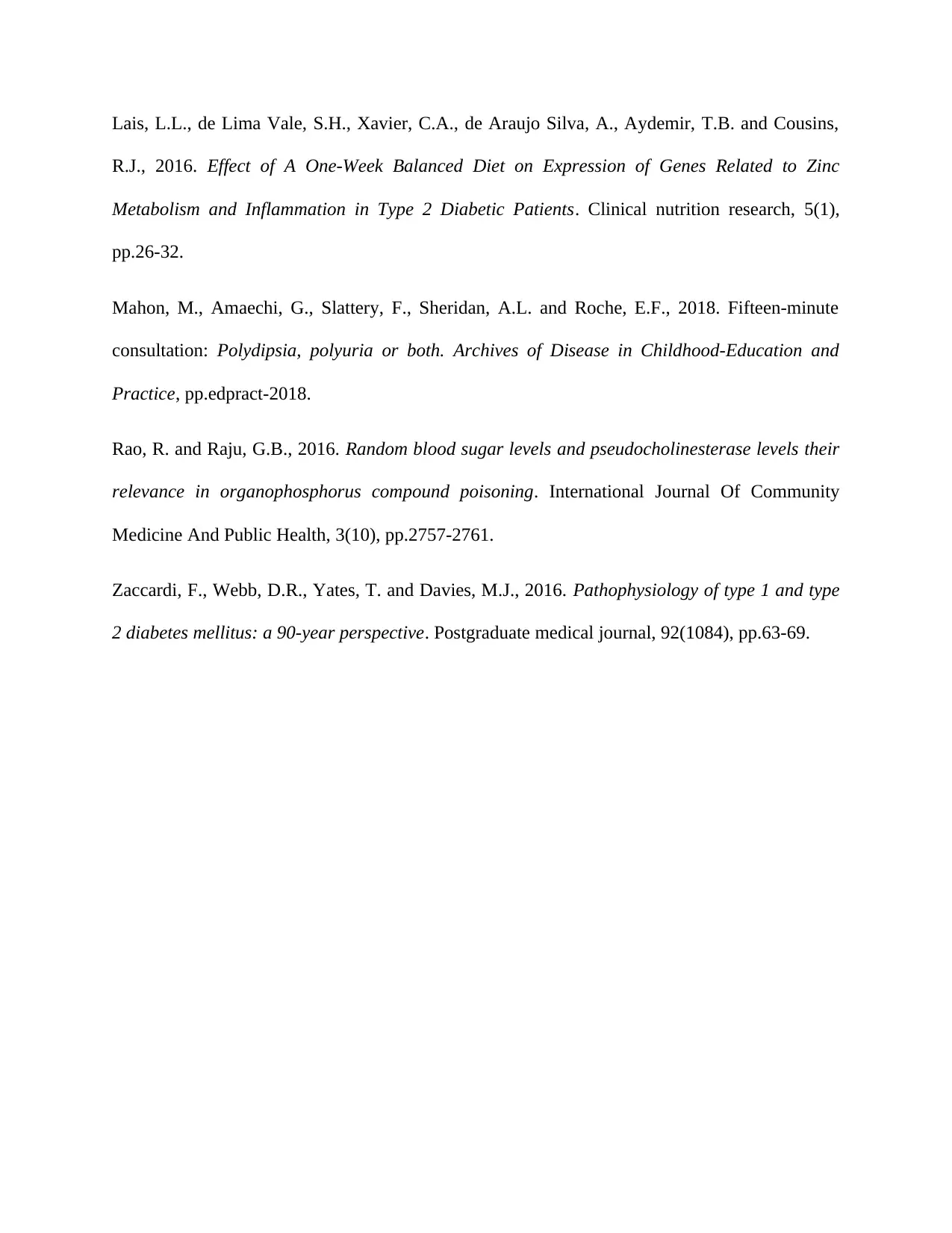
Lais, L.L., de Lima Vale, S.H., Xavier, C.A., de Araujo Silva, A., Aydemir, T.B. and Cousins,
R.J., 2016. Effect of A One-Week Balanced Diet on Expression of Genes Related to Zinc
Metabolism and Inflammation in Type 2 Diabetic Patients. Clinical nutrition research, 5(1),
pp.26-32.
Mahon, M., Amaechi, G., Slattery, F., Sheridan, A.L. and Roche, E.F., 2018. Fifteen-minute
consultation: Polydipsia, polyuria or both. Archives of Disease in Childhood-Education and
Practice, pp.edpract-2018.
Rao, R. and Raju, G.B., 2016. Random blood sugar levels and pseudocholinesterase levels their
relevance in organophosphorus compound poisoning. International Journal Of Community
Medicine And Public Health, 3(10), pp.2757-2761.
Zaccardi, F., Webb, D.R., Yates, T. and Davies, M.J., 2016. Pathophysiology of type 1 and type
2 diabetes mellitus: a 90-year perspective. Postgraduate medical journal, 92(1084), pp.63-69.
R.J., 2016. Effect of A One-Week Balanced Diet on Expression of Genes Related to Zinc
Metabolism and Inflammation in Type 2 Diabetic Patients. Clinical nutrition research, 5(1),
pp.26-32.
Mahon, M., Amaechi, G., Slattery, F., Sheridan, A.L. and Roche, E.F., 2018. Fifteen-minute
consultation: Polydipsia, polyuria or both. Archives of Disease in Childhood-Education and
Practice, pp.edpract-2018.
Rao, R. and Raju, G.B., 2016. Random blood sugar levels and pseudocholinesterase levels their
relevance in organophosphorus compound poisoning. International Journal Of Community
Medicine And Public Health, 3(10), pp.2757-2761.
Zaccardi, F., Webb, D.R., Yates, T. and Davies, M.J., 2016. Pathophysiology of type 1 and type
2 diabetes mellitus: a 90-year perspective. Postgraduate medical journal, 92(1084), pp.63-69.
⊘ This is a preview!⊘
Do you want full access?
Subscribe today to unlock all pages.

Trusted by 1+ million students worldwide
1 out of 6
Related Documents
Your All-in-One AI-Powered Toolkit for Academic Success.
+13062052269
info@desklib.com
Available 24*7 on WhatsApp / Email
![[object Object]](/_next/static/media/star-bottom.7253800d.svg)
Unlock your academic potential
Copyright © 2020–2025 A2Z Services. All Rights Reserved. Developed and managed by ZUCOL.





